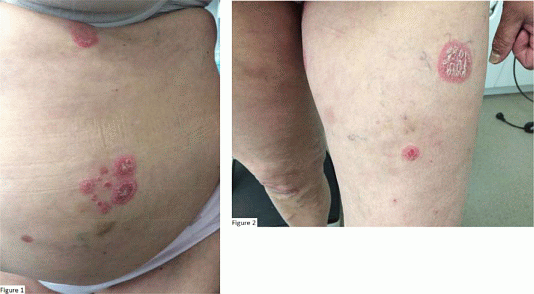BES2021 Belgian Endocrine Society 2021 Abstracts (26 abstracts)
Isomorphic (KOEBNER) phenomenon induced by insulin injections in psoriasis: a case report
Thijs Saartje 1 , Degraeve Corinne 2 & Coremans Peter 1
1Department of diabetes and endocrinology, AZ Nikolaas, Sint-Niklaas, Belgium; 2Dermatology private clinic, Kruibeke, Belgium
Introduction: Lipohypertrophy is by far the most common skin-related complication of insulin therapy. Less common dermatological complications of insulin injections include lipoatrophy, localized allergic reaction, subcutaneous abscess, localized amyloidosis and hyperpigmentation of the skin at the site of injection. We describe the Koebner phenomenon in an insulin requiring type 2 diabetic patient during a psoriasis flare-up.
Case report: A 56-year old woman with type 2 diabetes for more than 30 years and treated with insulin since 3 years was evaluated at the diabetes clinic for routine follow-up. She also suffered from long standing severe psoriasis, for which she had been treated with methotrexate as well as a local treatment with calcipotriol 50 microgram/gram and betamethasone dipropionate 0.5 milligram/gram. 8 months earlier, the treatment with methotrexate was interrupted due to liver dysfunction. Concerning her diabetes, lispro was used as prandial and glargine as basal insulin. Her other medications were atorvastatin, aspirin and metformin. Hemoglobin A1c was 7.0 % and during the past months insulin need was stable. After withdrawal of methotrexate a serious psoriasis flare-up including involvement of her nails and her skin, localized at elbows, gluteal, lumbosacral and submammary regions was noticed. Also new sharply demarcated, erythematous, oval, red and scaly plaques that differ in size were observed at the insulin injection sites on the lower abdomen and the both anterior proximal thighs (figures 1 and 2). These plaques developed 48 to 72 hours after injection with both insulin lispro and glargine. They resolved with residual hyperpigmentation over a period of 2 to 3 weeks after once daily application with calcipotriol 50 microgram/gram and betamethasone dipropionate 0.5 milligram/gram. Psoriasis-associated Koebner phenomenon due to insulin injections was diagnosed. Ciclosporin was initiated, after 2 months no significant improvement was noticed. Six to eight weeks after initiating treatment with guselkumab (IL-23 inhibitor) all plaques, including those at the injection sites, resolved completely and no new lesions developed.
Discussion: Koebner phenomenon, also known as the isomorphic response, describes the appearance of new skin lesions of the same kind of a pre-existing skin disease along sites of cutaneous injury. This phenomenon is mostly observed in patients with psoriasis, although it can also be seen in vitiligo and lichen planus.1Psoriasis is a chronic inflammatory skin disease associated with multiple comorbidities.2Observational studies established the association between psoriasis and the prevalence of diabetes. It has been proposed that the chronic systemic inflammation, seen in the psoriatic state, induces insulin resistance. The relative risk of developing diabetes in psoriasis is estimated to be 1.50.3To the best of our knowledge there are only 2 other cases describing the Koebner phenomenon response in patients with psoriasis induced by insulin injections.4,5 Our case report is clearly different from the 2 other cases because these former reported patients used NPH insulin, whereas this case report describes a patient with koebnerization in psoriasis due to injections with insulin analogues.
Conclusion: Our case report confirms the possibility of inducing new psoriasis lesions at insulin injection sites, the so called Koebner phenomenon. Thus, clinicians should be aware of this possibility in insulin requiring diabetic patients with psoriasis. Therefore, we emphasize the importance of thoroughly inspection of all insulin injection sites and catheter insertion sites in insulin pump therapy, not only for excluding lipohypertrophy, but also for excluding other dermatological problems associated with insulin injections. We would not be surprised to the Koebner phenomenon emerging also in patients using flash glucose monitoring, continuous glucose monitoring or patch pumps in the future.
References: 1.Diani M, Cozzi C, Altomare G. Heinrich Koebner and his phenomenon. JAMA Dermatol. 2016; 152: 919.
2. Boehncke WH, Schön MP. Psoriasis. Lancet. 2015; 386: 983-994.
3. Coto-Segura P, Eiris-Salvado N, González-Lara L, et al. Psoriasis, psoriatic arthritis and type 2 diabetes mellitus: a systematic review and meta-analysis. Br J Dermatol. 2013; 169: 783-793.
4. Federman DG, Kravetz JD, Kashaf SS, Kirsner RS. Pokes, papules, plaques. Am J Med. 2010; 123: 514-516.
5. Wang P, Ran Y. Subcutaneous injection of isophane protamine biosynthetic human insulin induced psoriasis at the injection site. Eur J Dermatol. 2011; 21: 807-808.
 }
}



